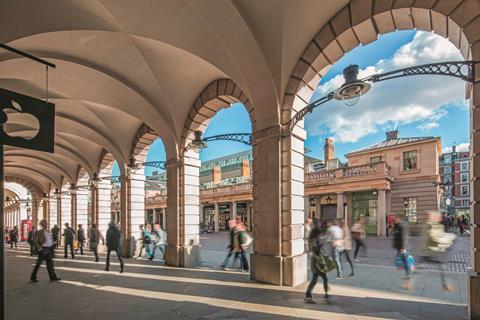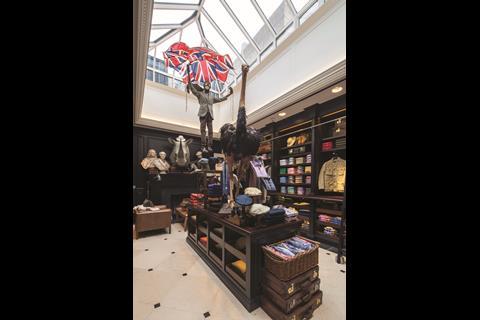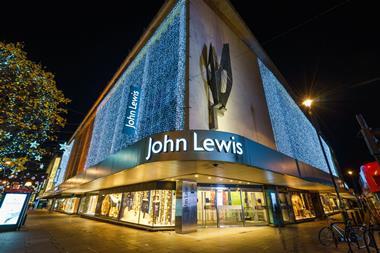Covent Garden might be in the middle of London’s West End but, like other shopping areas, could not afford to rest on its laurels.
It’s a difficult time for nearly every high street - no matter how high profile a destination might be, there’s no room
for complacency.
In 2006, Covent Garden was starting to feel the effects of a lack of direction. Footfall was still high, meaning the area was never going to suffer to the same extent as some other UK high streets, but there was still work to do.
“It was very much a shopping, dining and cultural location, but it had become a bit unloved,” says Sarah-Jane Curtis, Covent Garden director at Capital and Counties, which now owns a large part of the main piazza area. “It was a tiny bit of a down at heel, tourist-dominated location.”
Capital and Counties started to acquire as much of the area as possible in 2006, and the company now owns £1bn worth of property in the central Covent Garden market and the streets around it.
Its work so far has focused largely on King Street, which is now home to retailers including French fashion label Sandro and perfume brand Jo Malone. Henrietta Street and Floral Street will be the next focus - in the case of the former, Capital and Counties wants it to have an ‘edgy’ feel, and in the latter, a focus on contemporary luxury menswear and womenswear anchored by the current Paul Smith store at one end. The developer is looking for another retailer to anchor the other end of the street.
Curtis says the aim is to create an alternative destination to Regent Street and Oxford Street, and to create a mix of food and non-food retailing that will attract affluent Londoners.
The focus throughout the project has been on increasing the number of shoppers from within the M25.
“Londoners are quite high spending, and they are more likely to come back and spend,” says Curtis. “We don’t want to alienate tourists but they will only return once a year or every five years. It’s about creating loyalty.”
She adds that Londoners tend to be the hardest shoppers to please - in the same way that tourists and visitors will flock to wherever the locals are known to frequent in New York or Paris, Londoners are likely to bring foreign and domestic visitors in their wake as well. “Londoners are the most discerning about their city. If they start going there everyone else does,” she explains.
The key to success
Curtis says the scheme has been successful so far because of two key factors. Firstly, the company owns a critical mass of property in the area and so is able to manage the retail mix carefully. Secondly, it decided on a strategy early, which, Curtis says, is vital for high streets struggling to survive.
“We wanted a vibrant, aspirational location for Londoners that is a bit more ‘of the moment’,” she says. “The strategy was to acquire as much as we can at the heart of Covent Garden and run it very proactively.”
This means carefully curating a retail mix that appeals to the target group. “We are reinventing the mix of Covent Garden to suit the demographic profile. We want to bring entry level luxury to Covent Garden.” The emphasis, she adds, is on a unique, interesting mix.

“It was about looking at the type of people coming here and asking what was missing, and trying to create a point of difference.” While other areas of the country have a different dynamic - and don’t have the benefit of Covent Garden’s naturally high footfall - the work that has gone into the retail offer is testament to how even the best locations can fall behind if they’re not proactively managed.
“We have a captive audience - we don’t want more people, we’d just like to get more locals back,” Curtis says.
“It’s awareness of Covent Garden as a location that we need to work on.”
The scheme is a good example of how a clear strategy and vision is a crucial part of ensuring an area’s success.
It also demonstrates how helpful it can be if one company owns a large section of real estate in a given area. “The most successful retail locations are those managed by one organisation,” Curtis says. “We have a very proactive approach. Since 2006, we’ve been acquiring as much as we can, and a lot of this has happened in the last two and a half years.”
The catalyst for the start of the changes was the signing of the Apple branch, which takes up a good proportion of one side of the main market square. The store is still Europe’s largest Apple store, housing the US technology giant’s EU headquarters, and it focuses on attracting family shoppers.
The emphasis has since been on reinventing the retail mix and bringing something different to London.
Shoppers can find a range of mainstream brands on Regent Street and Oxford Street, and Curtis says the aim has always been to provide something different. Bond Street has the high-end luxury market tied up, so Covent Garden is pitched slightly below that.
“We want to bring new brands into the UK,” Curtis says. “Or we want to have an eclectic part of a brand. The retail mix needs to be diverse.” This means US labels opening their first stores in the country, such as edgy fashion brand Opening Ceremony, or high-end labels such as Chanel trying something new.
Chanel has opened its first beauty and fragrance-only store in the market square, and is trying new ideas in the area. Over Mother’s Day weekend, it opened a three-day, pop-up flower stall with fragrance assistants on hand to offer consultations. The stall attracted reams of press inches and is emblematic of how Capital and Counties want the area to be used, Curtis says.
“We are bringing entry-level luxury to Covent Garden,” she says. “The market building provides accessible luxury and is interesting and unique.” French patisserie Ladurée also has a cafe and store in the market.
On King Street, the focus is on fashion. French label Sandro and Sienna Miller’s brand, Twenty8Twelve, are opening and menswear label Hackett has a five-storey shop on the street. “We want to know who is new and interesting,” Curtis says. “It’s a very proactive approach, so we’ll go and talk to people in New York or Copenhagen and tell them about what we’re doing.”
King Street’s buildings are well suited to quirky, higher-end labels - many of the buildings are listed and need to be fitted out creatively. “One of our biggest challenges is improving the shopfront on listed buildings. It’s contrary to the council’s policy to put big glass shopfronts in buildings that weren’t designed for it.” Curtis says the stores on the street look good, but that retailers need to be flexible. “It’s about working creatively at it. But you need retailers to be able to work with us on this. There are no standardised units.” It helps, she observes, that more retailers are now looking to create an experience in their stores, instead of opening identical branches.
A large part of improving the offer at Covent Garden has been down to introducing better restaurants and bars.
After being in danger of becoming dominated by sub-standard tourist cafes and restaurants, Curtis says Capital and Counties has worked hard to raise standards.
This hard work paid off this year after the area landed the UK branch of Balthazar, the much-lauded New York restaurant of the same name. Also on the billing is Jamie Oliver’s Union Jacks and US fast-food chain Shake Shack, which hasn’t before traded in the UK.
Brand power
The process of getting new restaurants and retailers into the area has required imaginative thinking. Curtis says the developer has offered more flexible rent deals, such as turnover-related ones, to woo certain brands into the area, and says retailers have been frank in their demands. “They’re keen to get value for money,” she says.
“You’ve got to be able to justify service charges and things, which is absolutely right in this market.” She says the power of certain brands means they are worth negotiating with - and rents are now starting to creep up as the character of the area changes.
Covent Garden is in some ways typical of high streets across the country, although Curtis points out that the area’s dynamics are different to other town centres. But there is a role for local authorities to work closely with retailers and landlords to try to improve areas. “Local councils need to work more closely with property owners, and perhaps look at financial breaks to get people in there,” she says. But while it’s possible to conceive a high street vision that will chime with today’s shoppers, the most crucial factor for success is demographics. “If the social demographics aren’t there, the spend isn’t there,” she emphasises.
Changing the character of an area is not easy - it can take years of slowly acquiring more property and working with retailers. The right brands must be persuaded into buildings and the wrong brands moved elsewhere when their lease is up, and there’s the issue of the feel of the area and the marketing to raise awareness - re-paving the road on King Street alone cost £1.5m.
And while it has come a long way, Covent Garden’s facelift is far from over. Curtis says there are plans to gradually move the food offer in the main market to the south side of the piazza, and there are other brands on the hit list. Topshop is a particular target, although it’s likely it would go onto Long Acre with H&M and Zara.
Covent Garden proves that not even a West End, London location guarantees success if not managed carefully.
For a retail area to continue to succeed, it takes years of strategic planning and investment.
Covent Garden in numbers
- ABC1 shoppers 89% of the total, compared with about 50% of the total in 2006
- Annual visitors 45 million
- Londoners 53% of total shoppers
- Average dwell time 93 minutes, compared with about 72 minutes in 2012
- Average retail spend 2013: £100 per visit





























No comments yet